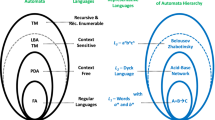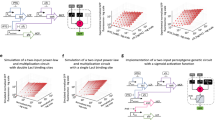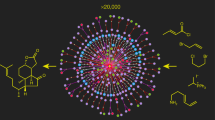Abstract
Research at the interface between chemistry and cybernetics has led to reports of ‘programmable molecules’, but what does it mean to say ‘we programmed a set of solution-phase molecules to do X’? A survey of recently implemented solution-phase circuitry1,2,3,4,5,6,7,8,9,10,11,12,13,14,15 indicates that this statement could be replaced with ‘we pre-mixed a set of molecules to do X and functional subsets of X’. These hard-wired mixtures are then exposed to a set of molecular inputs, which can be interpreted as being keyed to human moves in a game, or as assertions of logical propositions. In nucleic acids-based systems, stemming from DNA computation16,17,18,19,20, these inputs can be seen as generic oligonucleotides. Here, we report using reconfigurable21,22,23 nucleic acid catalyst-based units to build a multipurpose reprogrammable molecular automaton that goes beyond single-purpose ‘hard-wired’ molecular automata. The automaton covers all possible responses to two consecutive sets of four inputs (such as four first and four second moves for a generic set of trivial two-player two-move games). This is a model system for more general molecular field programmable gate array (FPGA)-like devices that can be programmed by example, which means that the operator need not have any knowledge of molecular computing methods.
This is a preview of subscription content, access via your institution
Access options
Subscribe to this journal
Receive 12 print issues and online access
$259.00 per year
only $21.58 per issue
Buy this article
- Purchase on Springer Link
- Instant access to full article PDF
Prices may be subject to local taxes which are calculated during checkout



Similar content being viewed by others
References
de Silva, A. P. & McClenaghan, N. D. Proof-of-principle of molecular-scale arithmetic. J. Am. Chem. Soc. 122, 3965–3966 (2000).
Benenson, Y., Paz-Elizur, T., Adar, R., Keinan, E. & Shapiro, E. Programmable and autonomous computing machine made of biomolecules. Nature 414, 430–434 (2001).
Stojanovic, M. N. & Stefanovic, D. A deoxyribozyme-based molecular automaton. Nature Biotechnol. 21, 1069–1074 (2003).
Ashkenasy, G. & Ghadiri, M. R. Boolean logic functions of a synthetic peptide network. J. Am. Chem. Soc. 126, 11140–11141 (2004).
Benenson, Y., Gil, B., Ben-Dor, U., Adar, R. & Shapiro, E. An autonomous molecular computer for logical control of gene expression. Nature 429, 423–429 (2004).
Macdonald, J. et al. Medium scale integration of molecular logic gates in an automaton. Nano Lett. 6, 2598–2603 (2006).
Wu, G., Jonoska, N. & Seeman, N. C. Construction of a DNA nano-object directly demonstrates computation. Biosystems 98, 80–84 (2009).
Seelig, G., Soloveichik, D., Zhang, D. Y. & Winfree, E. Enzyme-free nucleic acid logic circuits. Science 314, 1585–1588 (2006).
Zhang, D. Y., Turberfield, A. J., Yurke, B. & Winfree, E. Engineering entropy-driven reactions and networks catalyzed by DNA. Science 318, 1121–1125 (2007).
Margulies, D., Felder, C. E., Melman, G. & Shanzer, A. A molecular keypad lock: a photochemical device capable of authorizing password entries. J. Am. Chem. Soc. 129, 347–354 (2007).
Ran, T., Kaplan, S. & Shapiro, E. Molecular implementation of simple logic programs. Nature Nanotech. 4, 642–648 (2009).
Magri, D. C., Brown, G. J., McClean, G. D. & de Silva, A. P. Communicating chemical congregation: a molecular AND logic gate with three chemical inputs as a ‘lab-on-a-molecule’ prototype. J. Am. Chem. Soc. 128, 4950–4951 (2006).
Wilner, O. I. et al. Enzyme cascades activated on topologically programmed DNA scaffolds. Nature Nanotech. 4, 249–254 (2009).
Shlyahovsky, B., Li, Y., Lioubashevski, O., Elbaz, J. & Willner, I. Logic gates and antisense DNA devices operating on a translator nucleic acid scaffold. ACS Nano 3, 1831–1843 (2009).
Privman, V., Tam, T. K., Pita, M. & Katz, E. Switchable electrode controlled by enzyme logic network system: approaching physiologically regulated bioelectronics. J. Am. Chem. Soc. 131, 1314–1321 (2009).
Adleman, L. M. Molecular computation of solutions to combinatorial problems. Science 266, 1021–1024 (1994).
Braich, R. S., Chelyapov, N., Johnson, C., Rothemund, P. W. & Adleman, L. Solution of a 20-variable 3-SAT problem on a DNA computer. Science 296, 499–502 (2002).
Ouyang, Q., Kaplan, P. D., Liu, S. & Libchaber, A. DNA solution of the maximal clique problem. Science 278, 446–449 (1997).
Faulhammer, D., Cukras, A. R., Lipton, R. J. & Landweber, L. F. Molecular computation: RNA solutions to chess problems. Proc. Natl Acad. Sci. USA 94, 1385–1389 (2000).
Liu, Q. et al. DNA computing on surfaces. Nature 403, 175–179 (2000).
Alves, S. et al. Open-chain polyamine ligands bearing an anthracene unit—chemosensors for logic operations at the molecular level. Eur. J. Inorg. Chem. 405–412 (2001).
Saghatelian, A., Volcker, N. H., Guchian, K. M., Lin, V. S. Y. & Ghadiri, M. R. DNA-based photonic logic gates: AND, NAND and INHIBIT. J. Am. Chem. Soc. 125, 346–347 (2003).
de Silva, A. P., Dobbin, C. M., Vance, T. P. & Wannalerse, B. Multiply reconfigurable ‘plug and play’ molecular logic via self-assembly. Chem. Commun. 1386–1388 (2009).
Stojanovic, M. N., Mitchell, T. E. & Stefanovic, D. Deoxyribozyme-based logic gates. J. Am. Chem. Soc. 124, 3555–3561 (2002).
Breaker, R. R. & Joyce, G. F. A DNA enzyme with Mg2+-dependent RNA phosphoesterase activity. Chem. Biol. 2, 655–660 (1995).
Stojanovic, M. N. & Stefanovic, D. Deoxyribozyme-based half-adder. J. Am. Chem. Soc. 125, 6673–6676 (2003).
Lederman, H., Macdonald, J., Stefanovic, D. & Stojanovic, M. N. Deoxyribozyme-based three-input logic gates and construction of a molecular full adder. Biochemistry 45, 1194–1199 (2006).
Yurke, B., Turberfield, A. J., Mills, A. P. Jr, Simmel, F. C. & Neumann, J. L. A DNA-fuelled molecular machine made of DNA. Nature 406, 605–608 (2000).
Acknowledgements
This material is based upon work supported by the National Science Foundation. M.N.S. is a Lymphoma and Leukemia Society Fellow. The authors are grateful to P. Jelenkovic and N. Dabby for comments and advice.
Author information
Authors and Affiliations
Contributions
R.P. supervised and coordinated experimental efforts, optimized gates, performed the majority of experiments, analysed results and participated in writing the paper. E.M. participated in the initial ideation of the game, performed experiments and analysed results. M.L. performed experiments and analysed results. D.S. performed the game strategy analysis computationally, ran simulations and participated in writing the paper. M.N.S. initiated the project, proposed the game with E.M., and wrote the initial version of the paper.
Corresponding author
Ethics declarations
Competing interests
The authors declare no competing financial interests.
Supplementary information
Supplementary information
Supplementary information (PDF 10798 kb)
Rights and permissions
About this article
Cite this article
Pei, R., Matamoros, E., Liu, M. et al. Training a molecular automaton to play a game. Nature Nanotech 5, 773–777 (2010). https://doi.org/10.1038/nnano.2010.194
Received:
Accepted:
Published:
Issue Date:
DOI: https://doi.org/10.1038/nnano.2010.194
This article is cited by
-
DNA-based programmable gate arrays for general-purpose DNA computing
Nature (2023)
-
Molecular convolutional neural networks with DNA regulatory circuits
Nature Machine Intelligence (2022)
-
Protease circuits for processing biological information
Nature Communications (2020)
-
Cancer diagnosis with DNA molecular computation
Nature Nanotechnology (2020)
-
Solving mazes with single-molecule DNA navigators
Nature Materials (2019)



